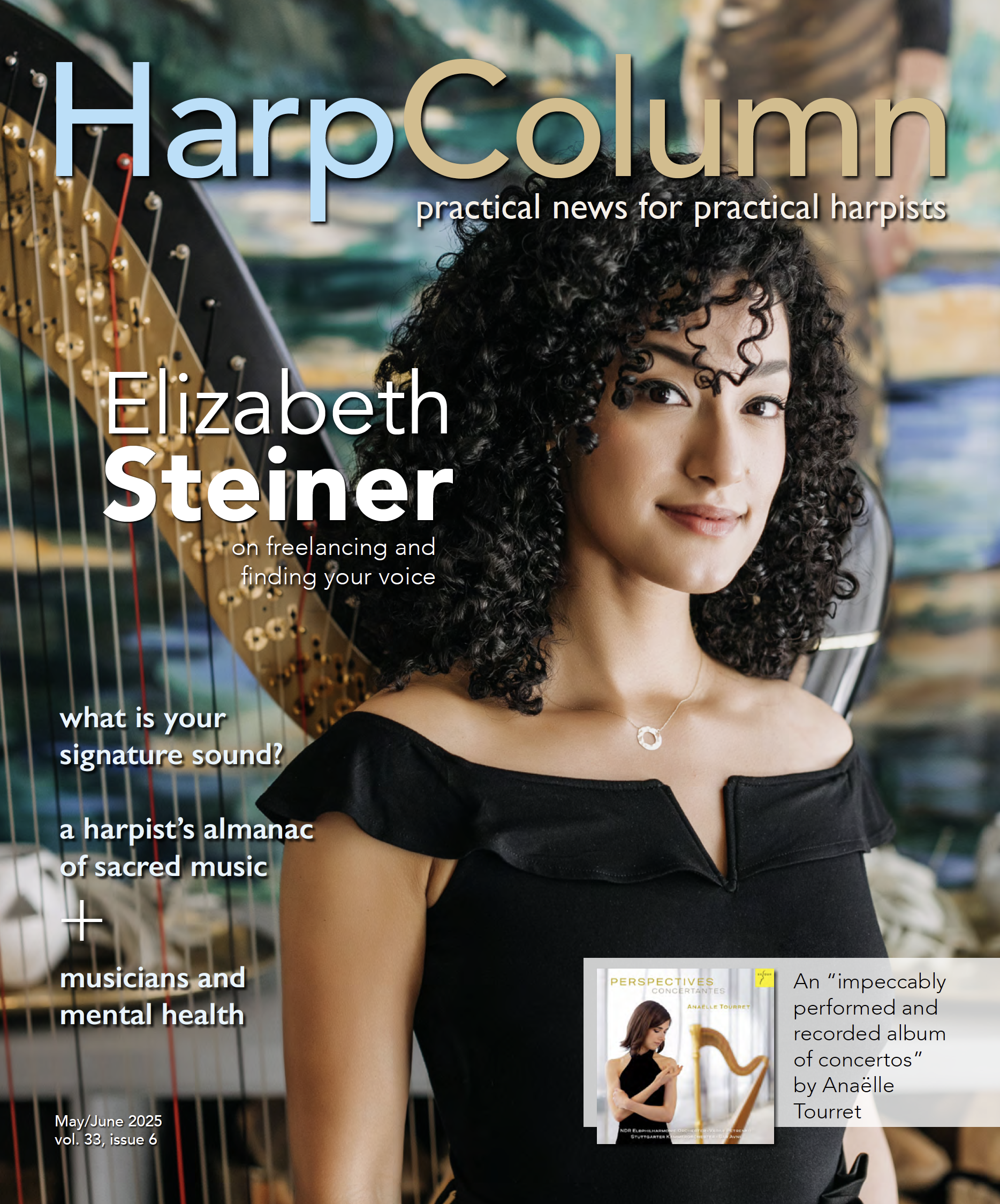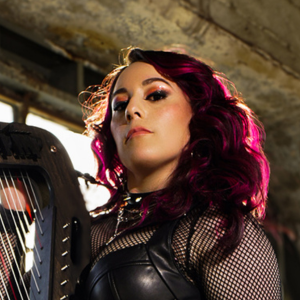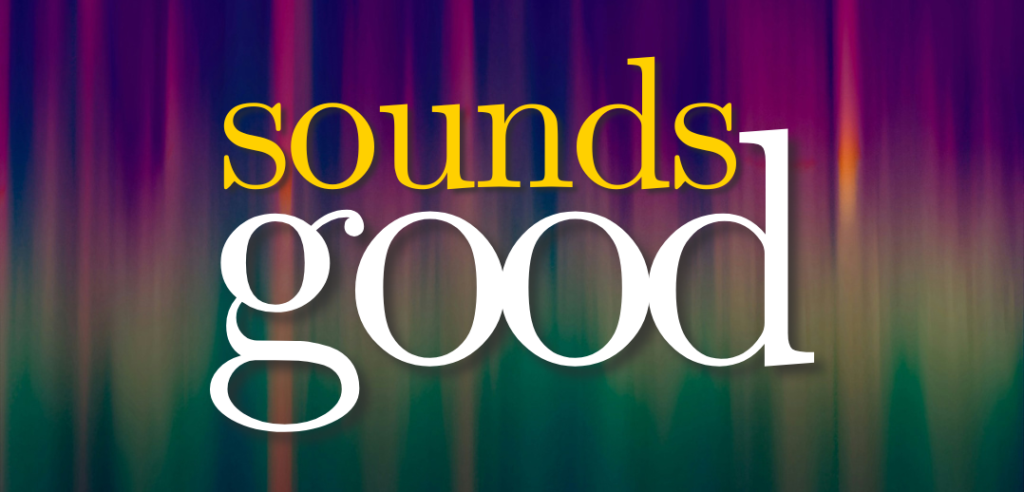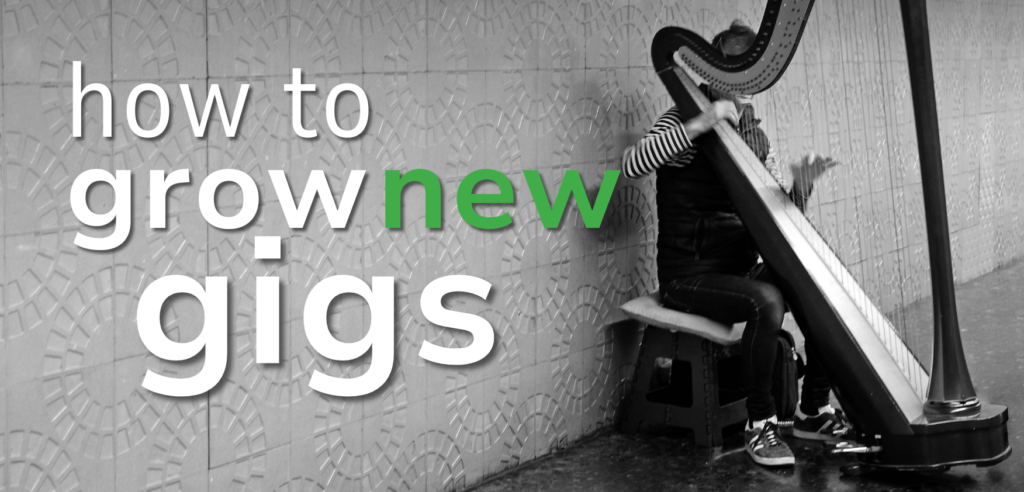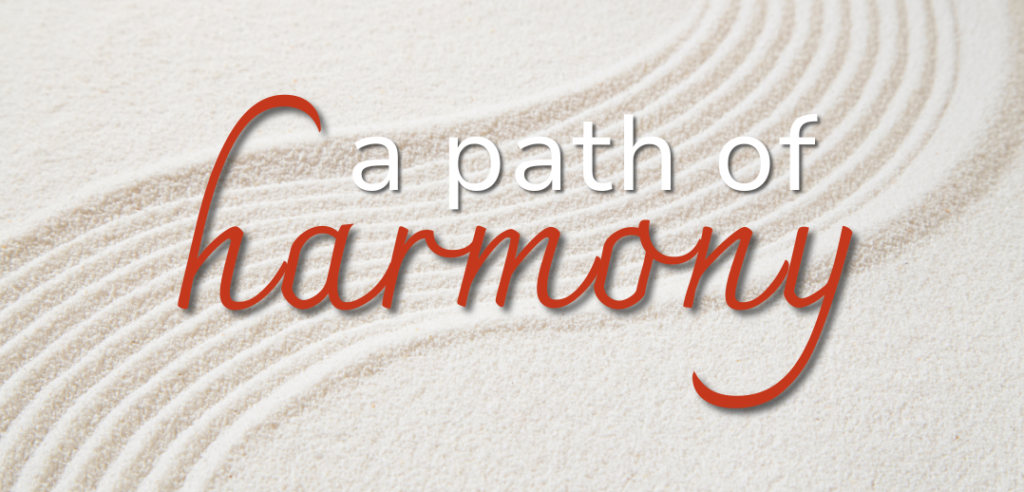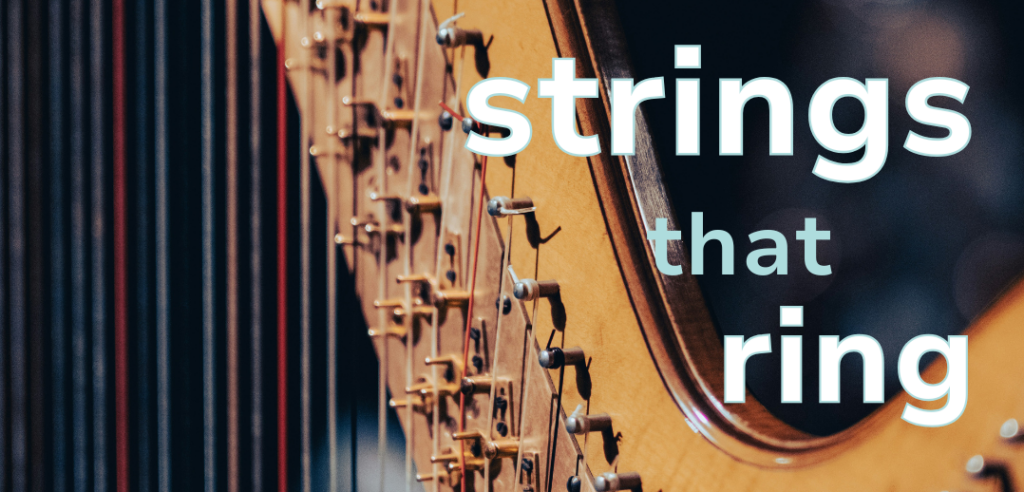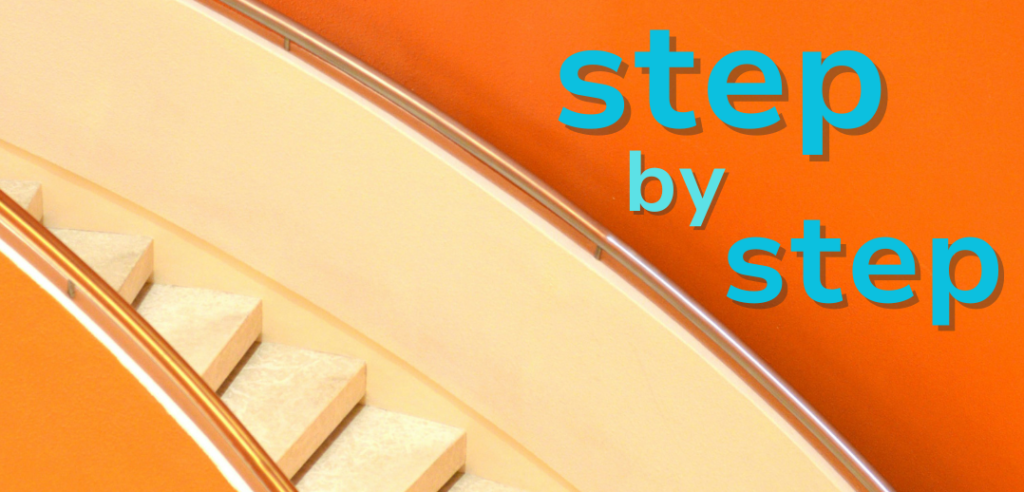Amplifying harps is different from amplifying other instruments. Harpists need to consider its unique tonal qualities and frequency range when considering amplification. Whether you want a natural, acoustic sound or something more experimental, the right gear can make all the difference. This guide will take you through everything you need to know about amplifying your harp, with some gear recommendations along the way. Disclaimer: I do not accept commissions or other forms of payment for my brand recommendations. I truly stand behind all of my statements and strongly believe in providing unbiased, unincentivized information. All opinions are my own.
Amplifying your harp involves three key stages: capturing the sound, boosting the signal, and choosing a speaker. Below is a step-by-step guide to help you navigate this process and find the best amplification setup for your needs.
STEP 1: CAPTURING YOUR HARP’S SOUND
There are two main ways to capture and amplify your harp’s sound in a live setting: a microphone or a pickup.
MICROPHONE: External devices that pick up sound waves in the air.
Connects to: XLR cable
Who is it for? Stationary gigs, harpists on a budget, casual players, gigs in quiet environments, singer-harpists, performances with live recordings.
Microphones come in a wide range of prices and are familiar to most musicians, making them a potentially simple and cost-effective way to amplify your harp. However, they require a stand or clip, can pick up background noise, and work best in quiet environments.
Types of Microphones
Dynamic: Budget-friendly (many under $100), durable, and commonly used for live performances. No external power needed. Typically have lower sound quality.
Condenser: Higher audio quality, commonly used in recording studios. Requires external power and is more fragile. Their extreme sensitivity to sound can be a good or bad thing, depending on the use.
Ribbon: High-end studio microphones with excellent sound quality but too delicate and expensive for live use.
Gear recommendations—Mics
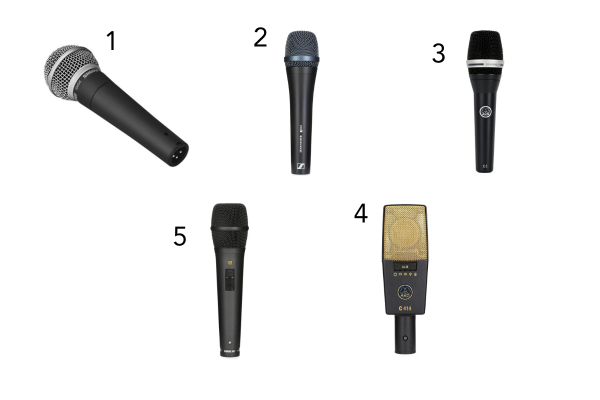
1. Sure SM58 Mic; 2. Sennheiser e945 Mic; 3. AKG C5 Mic; 4. AKG C414 XLII Mic; 5. Rode M2 Mic
For casual players: Any dynamic microphone will work, like the classic Shure SM58.
For stationary gigs, singer-harpists, or small to medium-sized harps: A high quality dynamic mic, like the Sennheiser e945, or durable condenser mic made for live sound, such as the AKG C5 or Rode M2, is ideal.
For larger harps and high-stakes performances: A stereo pair (one mic for high strings, one for low strings) is needed for full sound capture. This type of setup is cumbersome, so pickups would be a better alternative for this population.
For live recordings and studio work: High-quality stereo pair condensers like the AKG C414 XLII or XLS provide superior, pristine sound quality.
With all this said, I believe pickups to be the most convenient option for the majority of scenarios as microphones and stands are yet another piece of equipment to bring in our already full arsenal, so let’s dive into pickups.
PICKUP: Small sensors installed inside your harp to detect vibrations directly.
Connects to: Quarter-inch instrument cable (a typical guitar cable).
Who is it for? Professional gigs, harpists who need simple setups, gigs in loud environments, bigger harps.
Pickups are small devices installed on an instrument to capture sound by detecting vibrations. Unlike microphones, they are resistant to background noise, making them ideal for louder environments. Since pickups become part of your instrument, they simplify your setup and eliminate the need for extra stands or cases. The vast majority of electroacoustic harps are simply regular acoustic harps with a pickup (or multiple) installed.
Be wary of cheap pickups—you typically get what you pay for. Pickups vary significantly in the number of sensors and the technology used, both of which greatly affect sound quality. Investing in a high-quality pickup is money well-spent.
The most common type of pickup is the piezo or contact pickup, which uses small sensors placed in strategic locations on an instrument. The more sensors a pickup has, the more accurately it can replicate sound. Proper placement is key for achieving the best tone.
Gear Recommendations—Pickups
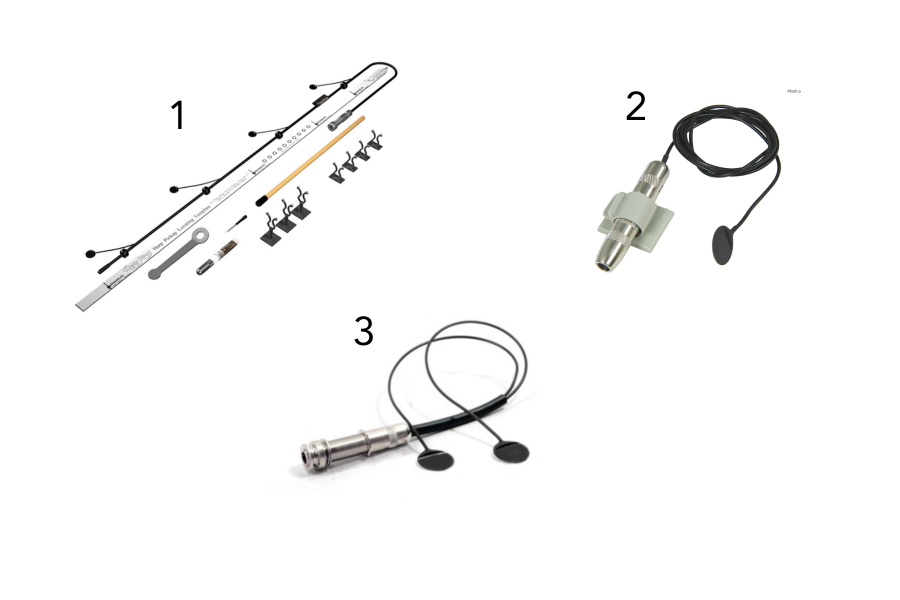
1. Dusty Strings Pickup; 2. Fishman Soundboard Transducer for Harp & Piano; 3. K&K Big Twin Pickup
Best overall: In my opinion, the Dusty Strings Pickup comes out on top in terms of the most natural sound replication, but you will pay a premium for this. The pickup is designed for the harp’s specific frequency range, featuring multiple sensors that go up the entire range of the instrument.
I have seen some cheaper copycat pickups pop up here and there made by smaller companies. I have heard good things about them but have not personally experienced or tried them. It is worth inquiring about them at your trusted harp shop.
Budget-friendly options: The K&K Big Twin pickup (originally for double bass) or the Fishman Soundboard Transducer for Harp & Piano both work well, but the audio quality they offer is not as high as a more expensive/premium pickup. Neither have particularly long cables or more than one or two sensors. Due to this, the sensors don’t reach the sparkly high end of the harp, creating a more mid- and bass-heavy tone when amplified.
STEP 2: BOOSTING THE SIGNAL
Microphones and pickups produce a weak signal that isn’t strong enough for an amp or sound system. This is why your harp might sound much quieter than an electric guitar when plugged into the same amp. To fix this, you need a preamp, which boosts and enhances your signal for proper amplification. Native electric instruments come with this built-in.
Some acoustic pickups come with a built-in preamp, but not all. If your harp came with a pickup, check with your manufacturer if it has a preamp.
Gear Recommendations—Preamps
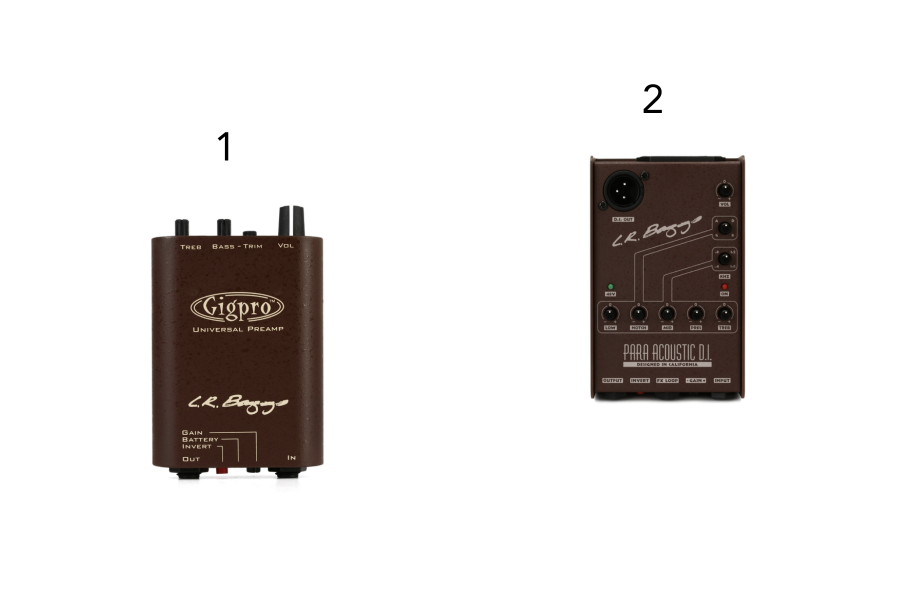
1. L.R. Baggs Gigpro Single Channel Preamp; 2. L.R. Baggs Para Acoustic D.I. Preamp
You can get fancy with them if you want to, but most acoustic guitar preamps will work well for harp.
Simple and budget-friendly: I’ve had good success with the L.R. Baggs Gigpro Single Channel Preamp. As of this article, this preamp is discontinued but can still be found in online marketplaces like Reverb. It clips onto your belt for easy access to volume and tone control. it only comes with a quarter-inch input.
Advanced tone control: The L.R. Baggs Para Acoustic D.I. works marvelously for the harp and comes with five-band EQ for more precise tone shaping (more on EQs in the Portability and Features section). This one comes with both a quarter-inch and XLR input for both mic and pickup compatibility.
Step 3: CHOOSING A SPEAKER
Here is where the fun begins! There are endless amps out there, and it can be confusing to know where to start. There are three major considerations:
• Tone: How the amp affects your instrument’s sound.
• volume and sound quality: Choosing the right power level for your performance needs.
• portability and features: The right balance between sound and convenience.
All three considerations ultimately come down to this one question: How will you be using the amp? Let’s explore all three considerations in detail.
FOR TONE—TYPES OF AMPLIFICATION
Amps come in several types to suit musicians’ needs and budget. From solid state amps to tube amps, they each have their own mechanism of action. To keep this article short, the types of amplification that are the most relevant for harpists are solid state amps and public address systems, commonly called PAs. Connect to them with any mono quarter-inch instrument cable.
Solid State Amps
Who is it for? Every harpist—there is a solid state amp for each need.
Solid state amps use electronic components to process and amplify sounds. Since they are rather straightforward, they can offer a clearer, more natural sound than other amp types. These amps are durable, lightweight, and require little maintenance, making them perfect for beginners who just want a reliable amp with no frills.
These amps range widely in price and quality, with every price point and performance level available. Some solid state amps also allow wireless use and Bluetooth compatibility, adding to their versatility. These amps start at budget-friendly price points—a huge plus for many. Your standard entry-level, battery-powered, and portable amp will be a solid state.
Pros:
Lower cost than other types. A big pro for the harpist on a budget.
Low maintenance. No need to worry about replacing parts after a few years.
No fx pedals? No problem. Many come with built-in fx.
Cons:
Sound quality. Lower end solid state amps tend to have poor sound quality. However, the quality goes up the higher you go in price.
Less dynamic. These amps do not have natural compression like the fancier tube amps. If you want that, you will need to get a compressor pedal.
Gear recommendations—Solid State Amps
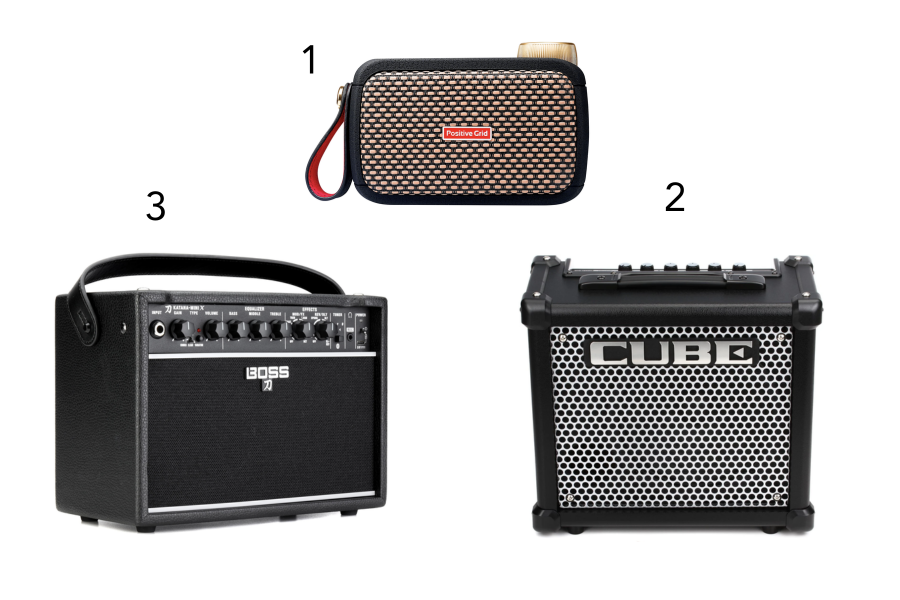
1. SparkGO Mini Amp ; 2. Boss Katana Mini Amp; 3. Roland Cube Amp
Small, battery-powered—for travelers, small harps, mobile gigs (playing while walking), and in-home electric harp practice.
Budget Options: TheSparkGO Mini comes with Bluetooth speaker compatibility, audio interface for mobile recording, app-powered effects, and is pocket-sized. The Boss Katana Mini has a fuller and louder sound than the SparkGO and comes with built-in EQ and distortion options.
Medium Budget: The Boss Katana Air sound quality and volume competes with standard-sized amps. Completely wireless for a cable-free performance. Comes with many built-in effects and USB audio interface compatibility.
Standard sized—for the average performer in a wide variety of stationary settings. Most of these amps offer some form of EQ settings and effects.
Medium Budget: Both the Fender and Marshall brands are extraordinarily popular for all types of musicians and each have their own distinct tone. They tend to colorize instruments to sound like a guitar. Amps from the rest of the Boss Katana series work very well with the harp’s sound and offer choices from beginner to pro. The Roland Cube is widely regarded amongst harpists as a solid battery-powered amp that keeps the harp tone mostly clean.
Solid State Amp variation: Acoustic Amps
Who is it for? The gigging harpist who needs the cleanest, most natural harp sound possible.
A useful type of solid state amp for traditional harpists, these are made for amplifying acoustic instruments with a wide frequency range, including acoustic guitars, strings, pianos, and harps. Since they are made especially for acoustic instruments, they provide a natural sound with little to no coloration. Many come with good EQ controls and multiple input channels—like a super-compact PA (more on PAs below). These amps may come with built-in effects like reverb and chorus. They don’t offer the best compatibility with guitar pedals.
Gear recommendations—Acoustic Amps
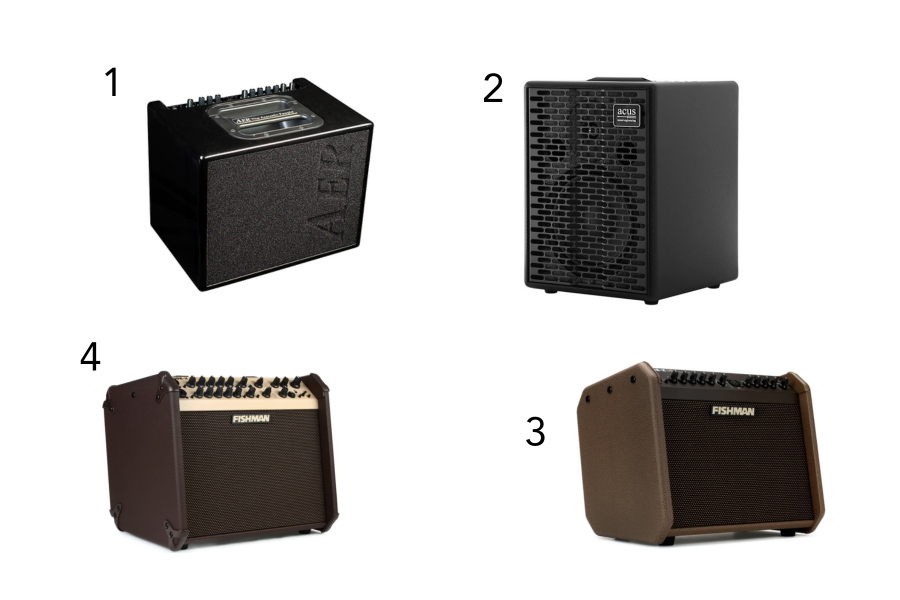
1. AER Domino Series Acoustic Amp ; 2. Acus OneForStrings 8 Acoustic Amp; 3. Fishman Loudbox Mini Charge Acoustic Amp; 4. Fishman Loudbox Artist Acoustic Amp
High Budget: The AER Domino series amps are on the pricey end, but they work beautifully with harp and come packed with features, like a compact PA system. They replicate the harp with extreme accuracy, making them some of the best amps available. The Acus OneForStrings series was tested to great satisfaction, especially the OneForStrings 8. They’re widely noted for being excellent with harps and bowed strings of all kinds, with a beautiful, twinkly high frequency boost. Be mindful to get the carrying bag as some of the knobs can be delicate. Its many inputs and multiple built-in effects are especially of note.
Medium Budget: The Fishman Loudbox series is a staple for many gigging harpists, for good reason. They are budget-friendly, portable, and some come with Bluetooth compatibility. Of the several variants, I recommend investing in the more powerful Loudbox Artist or Performer for utmost quality. In my experience, the Mini just isn’t quite there.
Battery powered: My only exception to the statement above is if you need a battery-powered acoustic amp. The Fishman Loudbox Mini Charge is the durable workhorse you need if you do a lot of busking or traveling and can compromise on a bit of sound quality.
PA System
Who is it for? Pros playing large or loud venues, harpists in bands.
While not a proper amp, a PA is worth mentioning as many harpists tend to opt for it instead of an amp. Even though they both amplify sound, PAs and amps serve different purposes.
A PA is the final stage of the amplification process. If you see a live concert, all the amps on stage will be miked up and amplified together by a stereo PA system usually located at either side of the stage.
In my experience, most employees at music stores will recommend a PA for harps of any kind.
Pros:
Will make your harp sound like a harp. PAs are designed to accurately convey an instrument’s sound. Because of this, the frequency response is very wide and flat. This is unlike typical amps that are made for recreating and coloring the limited frequencies of a guitar.
Multiple inputs. If you perform with a band or sing with your instrument, you can all connect together and thoroughly balance each signal.
Extensive EQ: They offer extensive control over specific frequencies—a major plus for those familiar with EQing and mixing.
Cons:
They are expensive. This choice is not for the harpist on a budget. A good PA system typically starts around $500 and goes up to several thousand dollars. Not all systems come with both speakers or stands, which adds to the cost.
Clunky and involved setup. If you are limited on transportation space, PA systems may not be a good choice. Many PA systems are huge, have multiple parts to carry, and are cumbersome.
Gear recommendattions—PA Systems
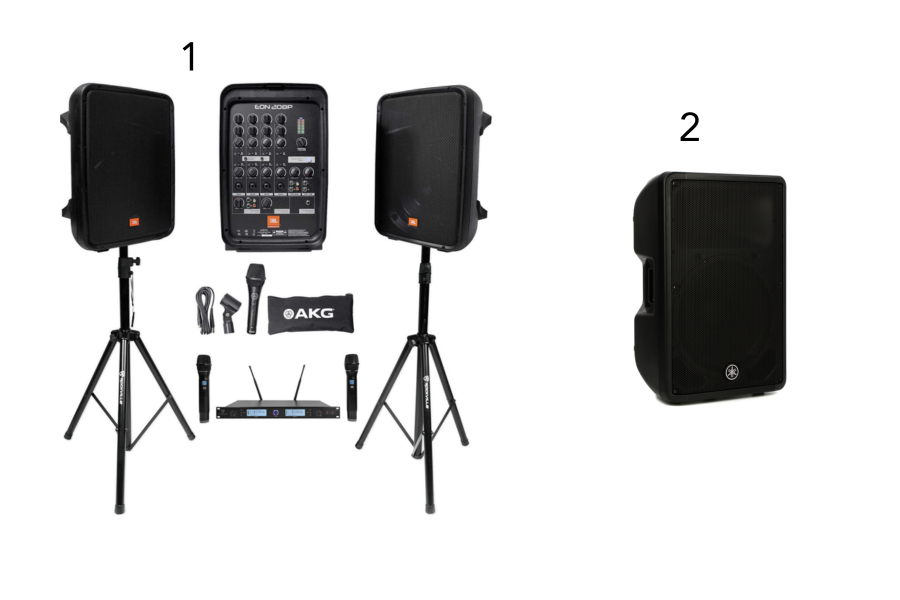
1. JBL Professional EON208P All-In-One PA System; 2. Yamaha DBR15 PA Speaker
Yamaha, JBL, and Mackie come out as industry leaders for PA systems. They have a multitude of options for different budgets that all do pretty much the same thing except they may differ in sound quality, volume, and mixer channels. The following PA systems are tried and tested by many musicians in the industry: the JBL Professional EON208P All-In-One System and the
Yamaha DBR series (speakers are sold individually). For setups with bands or for larger venues, I recommend the DBR12 or DBR15.
PA System variation: Active PA Speaker
Instead of a whole clunky PA system, a single, good quality active PA speaker is a fantastic choice for harpists. These types of speakers don’t have many extra settings, but will still typically provide one or two inputs, volume control, and sometimes EQ. All the benefits of a typical PA system still apply, minus the transportation downsides.
Who is it for? Harpists who are seeking an accurate portrayal of their harp’s sound with no frills.
Gear recommendations—Active PA Speakers
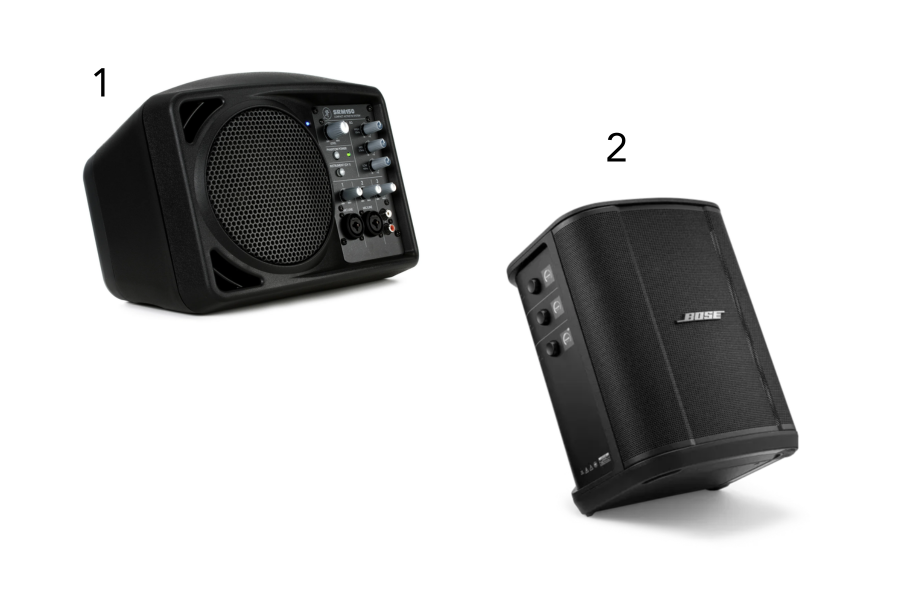
1. Mackie SRM 150 PA Speaker; 2. Bose S1Pro PA Speaker
The Yamaha DBR series allows you to buy a single speaker, the Mackie SRM150 is a good choice, and the Bose S1 Pro is the only wireless option of these PA recommendations.
For volume and sound quality—considerations
Now that we’ve covered the different types of amps and our recommendations, how do you choose the right one? Since we don’t always have the chance to test amps in person, it’s essential to learn how to compare their specs to make the best choice for your needs.
Choose a comfortable wattage…
Amps sound best with the volume raised halfway. Using a huge amp at its minimum volume or a tiny amp at its maximum volume both won’t sound optimal. Before selecting an amp, understand what volume range you need. Wattage is a rudimentary but easy indicator of volume range. If you can suffer the additional cost and weight, more wattage generally won’t hurt, because your amp will have more “headroom” for peaks and is likely to give a better frequency response.
…but don’t get too hung up on it
Wattage is by no means the only determining factor for perceived volume and sound quality.
When it comes to volume, wattage is a one-dimensional, linear scale. The human ear simply doesn’t work like that. The loudest sound our ear can tolerate is about a trillion times louder than the quietest sound it can detect. This is why in acoustics, usually the logarithmic decibel (dB) scale is used. Because wattage is linear, a note playing through a 100W amp sounds, at most, twice as loud as through a 10W amp, all other things equal.
Sound quality comes down to the percentage of harmonic distortion, represented as THD, at the volume and frequencies at which you’re playing. Harmonic distortion is not captured in wattage, but in the detailed amp specs. Manufacturers can state the THD for a certain frequency or range at a specific W or dB level. Since at lower frequencies the human ear needs more W or dB for the same loudness, distortion at the lower end will quickly add up.
This is all probably starting to sound really complicated, and unfortunately this is only the tip of the iceberg. To make matters worse, even if you were to get your head around all the details, comparing specs between different manufacturers is tricky due to ambiguous standards and often incomplete or optimistic representations.
Rules of thumb and how to compare
As a rule of thumb, 5-25W is a good range for home practice and 30-100W+ for the stage. Although keep in mind that, for reasons explained above, the difference between an 80W and a 100W amp is marginal and not worth compromising on cost or weight.
For sound quality, it’s good to have some wattage “headroom” (space between your playing level and the max level) at the volume you’re playing. But equally, if not more important is the size and frequency response of the speakers, the component quality, and housing material used.
To accurately compare brand specs, you would need significantly more knowledge than what we can fit in this article. However, it is easier to compare some different models from the same brands as they will typically state the specs consistently between their own models.
Now that we’ve scratched the surface on volume and sound quality, here are some things to look out for:
Minimal distortion. Distortion is represented in %THD. A lower percentage is better, but it matters at which frequencies.
Wide frequency range. This especially applies to those with large harps. It is important your amp handles the harp’s entire range plus an octave or two extra for its resonating frequencies.
Good frequency response. If there is any information available on this, look for a frequency response curve that follows the sensitivity of the human ear as much as possible for your chosen frequency range. Ideally, below 300 Hz the dB levels should go up, and above 300 Hz it should stay fairly flat.
Another helpful rule of thumb—when it comes to sound quality, you usually get what you pay for. A cheaper brand might boast a higher wattage, but if comparing the other specs is difficult, it is safe to bet that the sound quality and perceived volume is likely lower than a trusted brand.
For portability and features—options to consider
Ease of Transport
To reiterate, all the amps mentioned above come in different degrees of portability. For the traveling musician, busker, or music therapist, it makes sense to get a battery-powered amp. Now that we discussed the basics of volume and sound quality, you will be able to better assess if a battery-powered amp still meets your requirements.
A typical musician will want to have a fairly portable, powered amp as their main amp. The fuller the output sound, the heavier it will be. You have to ask yourself how much you are willing and able to carry.
Controls, Channels, and Connectivity
The more controls you have, the more you can tweak. Here are some examples of features you may find in different amps:
Input channels: Having more channels can be great if you play more instruments or are performing with a group.
Aux input: Great for playing along with external tracks.
EQ: Typically has three dials: low, mid, and high. These dials control how loud a range of frequencies are, allowing you to fine-tune your amp to your instrument’s sound and/or surroundings. A parametric EQ will allow you to control specific frequencies, an advanced feature that can help deal with resonant frequencies and/or interference.
Bluetooth: Allows the amp to turn into a big Bluetooth speaker.
Remote controls: Some amps have the ability to control or automate features via mobile apps.
DI Output: A balanced output for stage and studio that will make sound engineers happy.
Wireless: Provides cable-free stage playing. If you want a wireless amp, make sure to choose a high-quality one, which comes at a hefty price tag. The lower-end units tend to suffer from latency and sound quality loss. For wireless connections reliable enough to use in large live performances, you’ll need equipment beyond most budgets.
When choosing an amp, ask yourself how many control features you will truly need.
Built-in Effects
Built-in effects offer less flexibility and quality than individual effect pedals, but they can save you work, hassle, and equipment space.
Reverb and delay are most harpists’ favorite effects, and for good reason. They make harps sound even more magical than they already are. For this reason, they are wonderful to have built into an amp.
As you can see, there many choices for harp amplification with no one-size-fits-all option. When it comes to amps, many musicians tend to own multiple units to have one for every need (for the stage, for travel, and for practice).
Before making a purchase, we recommend visiting your local music store with your harp to test out different amps. Even though it is a hassle for those with bigger harps, it is worth it for the peace of mind and experimentation. Play in various styles with the full range of the harp to hear how each amp responds to various genres and the harp’s full frequency range. Ultimately, the most important consideration in choosing an amp is that you like how it sounds, not the individual specs.
I hope this guide serves as a helpful starting point in your journey to amplifying your harp! •
From the classical world to the trenches of heavy metal, Gabriela Gutierrez is an eclectic harpist that is passionate about driving innovation and shattering boundaries within the harp community. You can read more of her work at harp-e.com.




